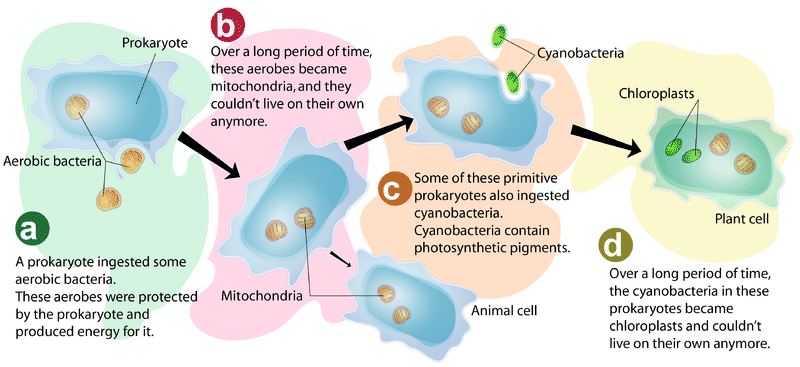16) Discuss the evolution of mitochondria and chloroplast as part of the cell, and What morphological innovations evolved in protists?
16) Discuss the evolution of mitochondria and chloroplast as part of the cell, and What morphological innovations evolved in protists?
answers :
The origin of mitochondria and chloroplasts

Mitochondria are often called the
powerhouses or energy factories of the cell. Their job is to make a steady
supply of adenosine triphosphate (ATP), the cell’s main energy-carrying
molecule. The process of making ATP using chemical energy from fuels such as
sugars is called cellular
respiration, and many of its steps happen inside the mitochondria.
The mitochondria
are suspended in the jelly-like cytosol of the cell. They are oval-shaped and
have two membranes: an outer one, surrounding the whole organelle, and an inner
one, with many inward protrusions called cristae that
increase surface area.
Chloroplasts are found only in plants
and photosynthetic algae. (Humans and other animals do not have chloroplasts.)
The chloroplast's job is to carry out a process called photosynthesis.
In photosynthesis, light energy is collected and used to
build sugars from carbon dioxide. The energy contained in these sugars is
harvested through a process called cellular respiration, which happens in the
mitochondria of both plant and animal cells.
Chloroplasts are
disc-shaped organelles found in the cytosol of a cell. They have outer and
inner membranes with an intermembrane space between them. If you passed through
the two layers of membrane and reached the space in the center, you’d find that
it contained membrane discs known as thylakoids, arranged
in interconnected stacks called grana
Both
mitochondria and chloroplasts contain their own DNA and ribosomes. endoSymbiosis
is a relationship in which organisms from two separate species live in a close,
dependent relationship. Endosymbiosis (endo- = “within”) is
a specific type of symbiosis where one organism lives inside the other.
1.
The first endosymbiotic event occurred: The ancestral
eukaryote consumed aerobic bacteria that evolved into mitochondria.
2.
In a second endosymbiotic event, the early eukaryote
consumed photosynthetic bacteria that evolved into chloroplasts."
Bacteria,
mitochondria, and chloroplasts are similar in size. Bacteria also have DNA and
ribosomes similar to those of mitochondria and chloroplasts.Based on this and
other evidence, scientists think host cells and bacteria formed endosymbiotic
relationships long ago, when individual host cells took in aerobic
(oxygen-using) and photosynthetic bacteria but did not destroy them. Through
millions of years of evolution, the aerobic bacteria became mitochondria and
the photosynthetic bacteria became chloroplasts.
Morphological
innovation of protists. All protists are eukaryotes
Multicellularity evolved multiple times in eukaryote. The protists have evolved from prokaryotes during which the nucleus
divided via mitosis, histones were associated with the DNA, an endomembrane
system and a cytoskeleton were formed, and they developed the ability to make
flagella or cilia for movement from one place to another.
The First Eukaryotic Cells
According to the endosymbiotic theory, the first eukaryotic cells evolved from a symbiotic relationship between two or more prokaryotic cells. Smaller prokaryotic cells were engulfed by (or invaded) larger prokaryotic cells. The small cells (now called endosymbionts) benefited from the relationship by getting a safe home and nutrients. The large cells (now called hosts) benefited by getting some of the organic molecules or energy released by the endosymbionts. Eventually, the endosymbionts evolved into organelles of the host cells. After that, neither could live without the other.
As shown in Figure below, some of the endosymbionts were aerobic bacteria. They were specialized to break down chemicals and release energy. They evolved into the mitochondria of eukaryotic cells. Some of the small cells were cyanobacteria. They were specialized for photosynthesis. They evolved into the chloroplasts of eukaryotic cells.
Endosymbiotic theory explains how eukaryotic cells arose.
Evidence for the Endosymbiotic Theory
Many pieces of evidence support the endosymbiotic theory. For example:
- Mitochondria and chloroplasts contain DNA that is different from the DNA found in the cell nucleus. Instead, it is similar to the circular DNA of bacteria.
- Mitochondria and chloroplasts are surrounded by their own plasma membranes, which are similar to bacterial membranes.
- New mitochondria and chloroplasts are produced through a process similar to binary fission. Bacteria also reproduce through binary fission.
- The internal structure and biochemistry of chloroplasts is very similar to that of cyanobacteria.

Comments
Post a Comment